Chapter 2
Gearing Up for Your Home Improvement Adventures
In This Chapter
 Stocking up your toolbox
Stocking up your toolbox
 Investing in great gadgets
Investing in great gadgets
H ow can you expect to create miracles without a magic wand? Of course, you can’t. And by the same token, you can’t expect to do projects around the house without reliable tools.
People take different approaches to owning tools. Tool-obsessed individuals look for any excuse to add to their collection — these folks simply can’t own too many tools. More practical do-it-yourselfers want to own only what’s required to do the job. Both approaches have their place, but whichever your persuasion, you need a stockpile of core tools — the essentials that you never want to be caught without.
If you think of every tool you buy as a long-term investment, you’ll gradually acquire a reliable stash that can get you through most home repairs and improvements. In this chapter, we walk you through the basic tools that are essential to any toolbox, but we can’t resist also tempting you with some of our favorite gadgets and gizmos designed to delight any do-it-yourselfer.

The Top Tools for Any Homebody
Shop for the tools you need in home centers, hardware stores, or any large mart. Don’t try to buy all the tools that you’ll ever need at one time; instead, buy tools as you need them. Focus on quality rather than quantity and buy the best-quality tool you can afford.
The tool-buying experience can be daunting for a first-timer. As you roam the aisles of megastores, don’t let the overwhelming selection intimidate you. Ask a salesperson for help and explain that you’re new to the do-it-yourself scene. A knowledgeable salesperson can help you make your decision by explaining how the wide range of prices reflects the quality, features, and materials of various tools.
So here it is, our list of the basic tools you need to get on the road to home improvement adventures:
 3/8-inch variable speed reversible drill: This tool, available as a plug-in or cordless, uses steel blades called bits to drive in or remove screws, drill holes, sand wood, mix piña coladas, and do other important home improvement tasks. See Figure 2-1.
3/8-inch variable speed reversible drill: This tool, available as a plug-in or cordless, uses steel blades called bits to drive in or remove screws, drill holes, sand wood, mix piña coladas, and do other important home improvement tasks. See Figure 2-1.
 Claw hammer: We recommend a 16-ounce hammer with a fiberglass handle to cushion the blow to your hand. Watch out for carpal tunnel syndrome, an injury that can occur from repetitive motions, such as constantly hitting your thumb and then hopping around the room.
Claw hammer: We recommend a 16-ounce hammer with a fiberglass handle to cushion the blow to your hand. Watch out for carpal tunnel syndrome, an injury that can occur from repetitive motions, such as constantly hitting your thumb and then hopping around the room.
 Pliers: Slip-joint pliers have toothed jaws that enable you to grip various sized objects, like a water pipe, the top of a gallon of mineral spirits, or the tape measure that you accidentally dropped into the toilet. Because the jaws are adjustable, pliers give you leverage to open and firmly grip an object.
Pliers: Slip-joint pliers have toothed jaws that enable you to grip various sized objects, like a water pipe, the top of a gallon of mineral spirits, or the tape measure that you accidentally dropped into the toilet. Because the jaws are adjustable, pliers give you leverage to open and firmly grip an object.
 Toolbox saw: A small, easy-to-use handsaw is useful for cutting such materials as paneling or shelving.
Toolbox saw: A small, easy-to-use handsaw is useful for cutting such materials as paneling or shelving.
 Assorted pack of screwdrivers: Be sure that you have both slotted (flat-head) and Phillips screwdrivers in a variety of sizes. The slotted type has a straight, flat blade; the Phillips blade has a cross or plus-sign that fits into the grooves of Phillips-head screws.
Assorted pack of screwdrivers: Be sure that you have both slotted (flat-head) and Phillips screwdrivers in a variety of sizes. The slotted type has a straight, flat blade; the Phillips blade has a cross or plus-sign that fits into the grooves of Phillips-head screws.
 Utility knife: Choose a compact knife with replaceable blades that’s strong enough to open heavy cardboard boxes and precise enough for trimming wallpaper.
Utility knife: Choose a compact knife with replaceable blades that’s strong enough to open heavy cardboard boxes and precise enough for trimming wallpaper.
.jpg)
Buy the type with a retractable blade; you’ll appreciate it the first time that you squat down with the knife in your pocket. (Ouch!)
 Staple gun: You can use this tool for a variety of jobs, like securing insulation, ceiling tile, plastic sheeting, and fabrics.
Staple gun: You can use this tool for a variety of jobs, like securing insulation, ceiling tile, plastic sheeting, and fabrics.
 Carpenter’s level: A straightedge tool that has a series of glass tubes containing liquid with a bubble of air. When the bubble in a single tube is framed between marks on the glass, it shows that the surface is level (horizontal) or plumb (vertical). See Figure 2-2.
Carpenter’s level: A straightedge tool that has a series of glass tubes containing liquid with a bubble of air. When the bubble in a single tube is framed between marks on the glass, it shows that the surface is level (horizontal) or plumb (vertical). See Figure 2-2.
 Metal file: Filing tools, such as those shown in Figure 2-3, are flat metal bars with shallow grooves that form teeth. Metal files are useful for sharpening the edges of scrapers, putty knives, and even shovels and garden trowels.
Metal file: Filing tools, such as those shown in Figure 2-3, are flat metal bars with shallow grooves that form teeth. Metal files are useful for sharpening the edges of scrapers, putty knives, and even shovels and garden trowels.
 Allen wrenches: These L-shaped metal bars, often sold in sets (see Figure 2-4), are designed for turning screws or bolts that have hexagonal sockets in their heads. This tool also goes by the name hex-key or setscrew wrench. Used to assemble everything from knock-down furniture to bicycles to gas grills, this tool was invented by a man named, umm, let’s see . . . we’ll have to get back to you on that one.
Allen wrenches: These L-shaped metal bars, often sold in sets (see Figure 2-4), are designed for turning screws or bolts that have hexagonal sockets in their heads. This tool also goes by the name hex-key or setscrew wrench. Used to assemble everything from knock-down furniture to bicycles to gas grills, this tool was invented by a man named, umm, let’s see . . . we’ll have to get back to you on that one.
|
Figure 2-1: An electric drill with a variety of bits. |
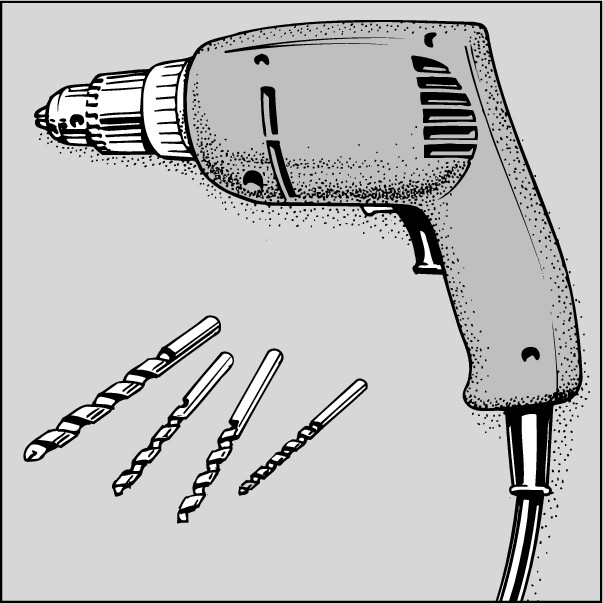
|
|
Figure 2-2: A standard carpenter’s level for finding level and plumb lines. |
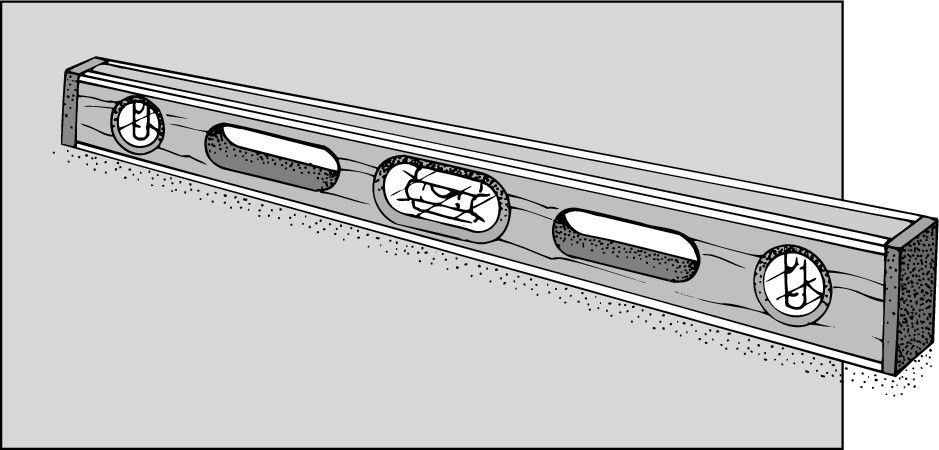
|
|
Figure 2-3: Metal files are good for more than breaking out of jail. |
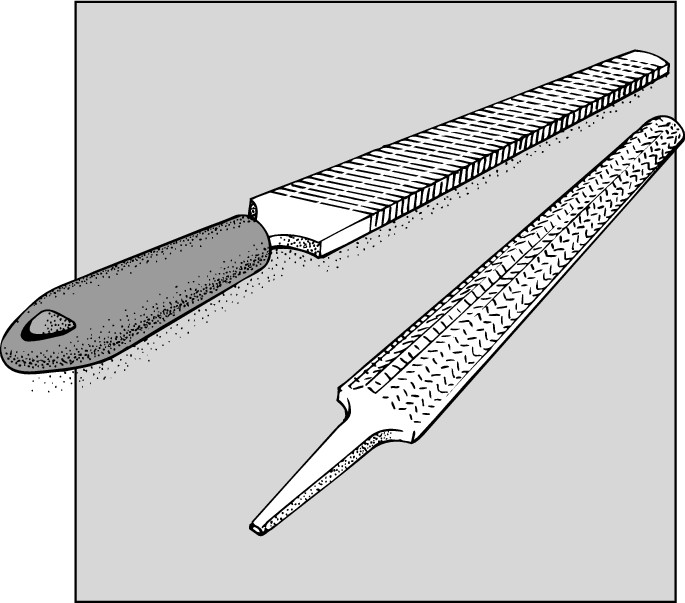
|
|
Figure 2-4: Many “assembly-required” items call for a set of Allen wrenches. |

|
Gizmos and Gear
Tools alone don’t lead to a life of joyful home improvements. You gotta have gadgets, too. Some really great gadgets are available to keep you organized, efficient, safe, and comfortable:
 Itty-bitty notebook: Keep a reference of your home improvement needs in your car or purse and refer to it when you shop. Instead of jotting down notes on scraps of paper that you’re more likely to lose than use, keep all this stuff in one place. Buying a new lampshade? Jot down the dimensions of the old one. Replacing the tray to your ice-cube maker? Make a note of the model number. Keep a record of paint colors and wallpaper patterns and a zillion other details (such as your wedding anniversary) in this little notebook.
Itty-bitty notebook: Keep a reference of your home improvement needs in your car or purse and refer to it when you shop. Instead of jotting down notes on scraps of paper that you’re more likely to lose than use, keep all this stuff in one place. Buying a new lampshade? Jot down the dimensions of the old one. Replacing the tray to your ice-cube maker? Make a note of the model number. Keep a record of paint colors and wallpaper patterns and a zillion other details (such as your wedding anniversary) in this little notebook.
 Tool tote: Keep a stash of the tools that you reach for most often in some kind of portable toolbox or crate. Be sure to include a stock of string, a pair of scissors, and other common household repair accessories. Many repairs must be done onsite, so having a tool tote that you can take with you to the project can be invaluable.
Tool tote: Keep a stash of the tools that you reach for most often in some kind of portable toolbox or crate. Be sure to include a stock of string, a pair of scissors, and other common household repair accessories. Many repairs must be done onsite, so having a tool tote that you can take with you to the project can be invaluable.
 Kneepads: Cushioned rubber pads, held in place with elastic strips, protect your knee joints from the impact of kneeling on hard surfaces. (Pretend that you’re in-line skating, and you won’t feel so silly.) Kneepads are especially important to wear when you’re crawling around on hard, debris-strewn surfaces.
Kneepads: Cushioned rubber pads, held in place with elastic strips, protect your knee joints from the impact of kneeling on hard surfaces. (Pretend that you’re in-line skating, and you won’t feel so silly.) Kneepads are especially important to wear when you’re crawling around on hard, debris-strewn surfaces.
.jpg)
 Goggles: Remember how your mom always made you wear a hat when it was cold outside? Well, if she saw you with a hammer or chipping away at something with a chisel, she’d say, “Put on your safety goggles!” A tiny chip of wood or a speck of metal or hardened paint can seriously damage your eyes, so protect them at all costs. Mother knows best.
Goggles: Remember how your mom always made you wear a hat when it was cold outside? Well, if she saw you with a hammer or chipping away at something with a chisel, she’d say, “Put on your safety goggles!” A tiny chip of wood or a speck of metal or hardened paint can seriously damage your eyes, so protect them at all costs. Mother knows best.
Goggles used to be clunky contraptions that only kids wanted to wear, but now they’re available in designer styles (well, sort of). Goggles are an inexpensive investment that may save your eyesight. Just remember to put them on.
 Gray duct tape: Sure, this product was designed for taping heating ducts, but it’s a national icon for do-it-yourselfers. Use it to seal window screens, patch old sneakers . . . heck, we’ve seen it patching dents in cars!
Gray duct tape: Sure, this product was designed for taping heating ducts, but it’s a national icon for do-it-yourselfers. Use it to seal window screens, patch old sneakers . . . heck, we’ve seen it patching dents in cars!
.jpg)
 Neon circuit tester: This two-buck item, pictured in Figure 2-5, can be a lifesaver whenever you have to work on an electrical switch, receptacle, or power source. Before you begin tinkering with a device, use this circuit tester to make sure that power isn’t flowing to it.
Neon circuit tester: This two-buck item, pictured in Figure 2-5, can be a lifesaver whenever you have to work on an electrical switch, receptacle, or power source. Before you begin tinkering with a device, use this circuit tester to make sure that power isn’t flowing to it.
 Wire brush: This item, shown in Figure 2-6, looks like a lethal toothbrush. It’s useful for scraping blistered paint, removing rust from metal, and taking corrosion off spark plugs.
Wire brush: This item, shown in Figure 2-6, looks like a lethal toothbrush. It’s useful for scraping blistered paint, removing rust from metal, and taking corrosion off spark plugs.
|
Figure 2-5: Electricity can be deadly. Use a circuit tester to make sure that wires are safe to handle. |
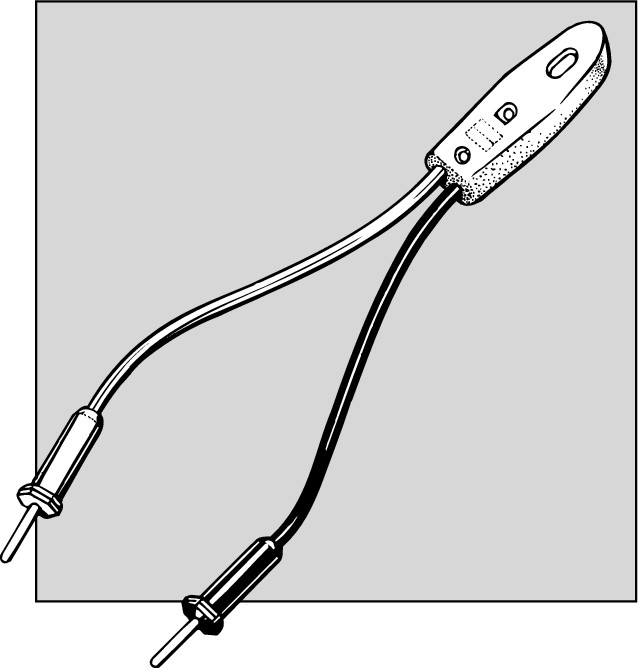
|
 Stud finder: No, this tool isn’t for finding hunky guys (unless they’re trapped in your walls). Wall studs are the vertical wood framing to which wallboard is fastened. A stud finder, shown in Figure 2-7, is an electronic device that locates the metal fasteners behind finished walls, which enables you to find a sturdy place to hang pictures, mirrors, and shelves.
Stud finder: No, this tool isn’t for finding hunky guys (unless they’re trapped in your walls). Wall studs are the vertical wood framing to which wallboard is fastened. A stud finder, shown in Figure 2-7, is an electronic device that locates the metal fasteners behind finished walls, which enables you to find a sturdy place to hang pictures, mirrors, and shelves.
 Ladders: Get a stepladder for household chores, such as changing light bulbs and painting rooms; get a taller self-supporting or extension-type ladder for outdoor maintenance like cleaning gutters and trimming trees. In general, aluminum ladders are lightweight and strong; wooden ladders are solid, heavy, and economical; and fiberglass ladders are strong, electrically nonconductive, and expensive. If you can afford it, fiberglass is the best choice.
Ladders: Get a stepladder for household chores, such as changing light bulbs and painting rooms; get a taller self-supporting or extension-type ladder for outdoor maintenance like cleaning gutters and trimming trees. In general, aluminum ladders are lightweight and strong; wooden ladders are solid, heavy, and economical; and fiberglass ladders are strong, electrically nonconductive, and expensive. If you can afford it, fiberglass is the best choice.

Every ladder is given a duty rating — its maximum safe-load capacity. This weight includes you plus the weight of any tools and materials you wear and haul up the ladder with you.
|
Figure 2-6: This is one brush you don’t want to take into the shower with you. |
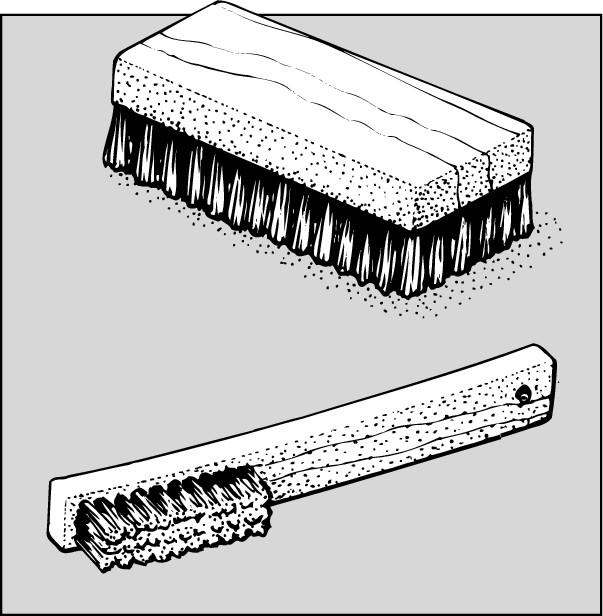
|
|
Figure 2-7: Use a stud finder to avoid hanging heavy items over hollow wallboard. |
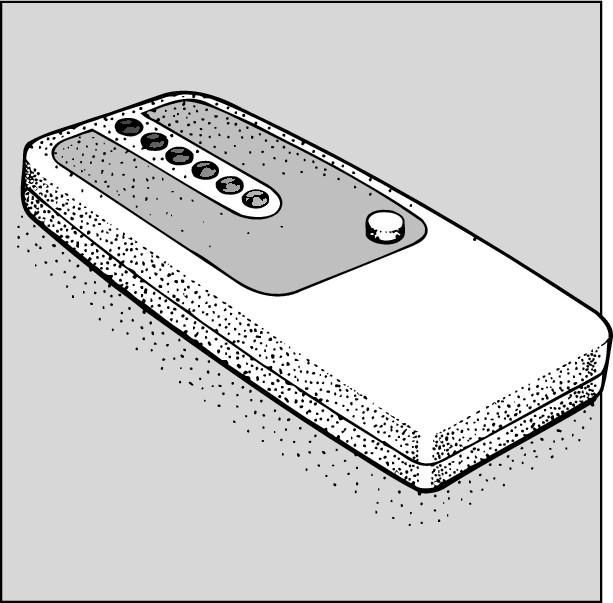
|